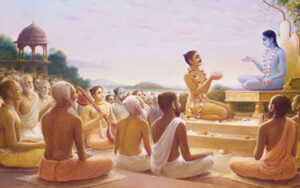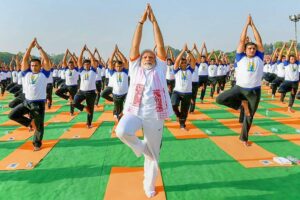Yoga is the practice of tolerating the consequences of being yourself.
– Bhagavad Gita
In today’s world, yoga has become a ubiquitous topic of conversation, with people extolling its numerous advantages and recognizing its essential role in everyday existence. The widespread recognition of yoga’s ability to address both physical and mental ailments is unsurprising. When the term “yoga” is mentioned, it often conjures images of individuals contorting their bodies into seemingly impossible poses. It’s possible that you may have never imagined that anyone other than acrobats could achieve such levels of flexibility and suppleness.
 Beyond the widely acknowledged effectiveness and benefits of yoga asanas, it is crucial to recognize that yoga encompasses more than just the physical postures that have gained popularity in recent decades. Contrary to being a passing modern trend, yoga has a rich history that stretches back several millennia. Astonishing as it may seem, yoga’s roots can be traced back to ancient times, dating back to BC eras. This enduring legacy is a significant factor in the widespread global attraction towards this time-honoured practice.
Beyond the widely acknowledged effectiveness and benefits of yoga asanas, it is crucial to recognize that yoga encompasses more than just the physical postures that have gained popularity in recent decades. Contrary to being a passing modern trend, yoga has a rich history that stretches back several millennia. Astonishing as it may seem, yoga’s roots can be traced back to ancient times, dating back to BC eras. This enduring legacy is a significant factor in the widespread global attraction towards this time-honoured practice.
The word yoga was derived from the Sanskrit word yuj which means ‘to join’ or ‘to unite’. This union is not, merely, about your nose touching your knees as you bend to touch your toes! The union referred to is that of your mind with your body. You integrate with your surroundings and nature. And, finally, your individual consciousness with the universal consciousness.
History of Yoga:
The history of yoga is a fascinating journey that spans thousands of years and encompasses diverse cultures and philosophical traditions. The origins of yoga can be traced back to ancient India, where it emerged as a comprehensive system for spiritual and physical well-being. Let’s delve into the history of yoga and explore its evolution over time.
 Origins in Ancient India:
Origins in Ancient India:
The exact origins of yoga are shrouded in the mists of time, with its roots believed to date back to the Indus Valley Civilization, around 3000 BCE. Archaeological evidence, such as seals depicting figures in yogic postures, suggests that yogic practices were prevalent in this ancient civilization. The early forms of yoga were closely intertwined with religious and spiritual beliefs, particularly within the Vedic tradition.
Vedic and Pre-classical Period:
The Vedic texts, including the Rigveda, Samaveda, and Atharvaveda, contain references to rituals, chants, and practices that resemble elements of yoga. The Upanishads, philosophical texts composed between 800 and 400 BCE, played a significant role in shaping yogic philosophy. They explored the concepts of self-realization, meditation, and the union of the individual soul (Atman) with the universal consciousness (Brahman).
Classical Period and the Yoga Sutras:
The Classical Period of yoga, around the 2nd century BCE to the 5th century CE, witnessed the emergence of systematic and codified practices. Sage Patanjali, in his seminal work known as the Yoga Sutras, presented a comprehensive framework for the practice of yoga. The Yoga Sutras defined the eight limbs of yoga (Ashtanga), which included ethical principles (Yamas and Niyamas), physical postures (Asanas), breath control (Pranayama), sensory withdrawal (Pratyahara), concentration (Dharana), meditation (Dhyana), and ultimate state of absorption (Samadhi).
Post-Classical Period and Hatha Yoga:
Following the Classical Period, yoga continued to evolve and adapt to changing cultural and social contexts. The Post-Classical Period saw the emergence of Hatha Yoga, a branch that focused on physical postures, breath control, and energy manipulation. Hatha Yoga aimed to balance and purify the body and mind in preparation for higher states of consciousness. Hatha Yoga texts, such as the Hatha Yoga Pradipika and the Gheranda Samhita, provided detailed instructions on asanas, pranayama, and other techniques.
 Yoga in Medieval India:
Yoga in Medieval India:
During the medieval period in India, various yoga traditions and lineages flourished, each with its unique practices and philosophies. The Bhakti movement emphasized devotion and surrender, while the Natha tradition integrated yogic practices with tantric rituals. The contributions of influential yogis, such as Matsyendranath and Gorakshanath, played a crucial role in spreading the teachings of yoga across the subcontinent.
Yoga’s Encounter with the West:
The 19th and early 20th centuries marked a significant turning point for yoga’s interaction with the Western world. Indian scholars and spiritual leaders, such as Swami Vivekananda and Paramahansa Yogananda, introduced yoga to the West, attracting interest and sparking a curiosity for Eastern spiritual practices. However, it was in the mid-20th century that yoga gained broader popularity in the Western world.
Modern Yoga and Global Popularity:
Yoga’s rise to global prominence can be attributed to several influential figures and events. B.K.S. Iyengar, T.K.V. Desikachar, and Pattabhi Jois, among others, played vital roles in spreading the teachings of yoga worldwide. Yoga masters from India travelled internationally, conducting workshops and establishing yoga centres, which contributed to its widespread adoption.
 In recent decades, yoga has evolved to meet the needs and preferences of diverse practitioners. Various styles, such as Vinyasa, Bikram, Ashtanga, and Kundalini, have gained popularity, offering practitioners different approaches and emphases within the broader framework of yoga.
In recent decades, yoga has evolved to meet the needs and preferences of diverse practitioners. Various styles, such as Vinyasa, Bikram, Ashtanga, and Kundalini, have gained popularity, offering practitioners different approaches and emphases within the broader framework of yoga.
Today, yoga is not limited to physical exercises but is recognized as a holistic practice that promotes physical health, mental well-being, and spiritual growth. Its benefits extend beyond flexibility and strength, encompassing stress reduction, improved focus, emotional balance, and a deeper connection to oneself.
The history of yoga is an intricate tapestry that weaves together ancient Indian philosophies, spiritual traditions, and cultural influences. From its origins in the Indus Valley Civilization to its current global popularity, yoga has evolved and adapted to the changing times while retaining its core principles of unity, self-realization, and inner transformation.
Benefits of Yoga:
Yoga offers a multitude of benefits for both the body and mind. Its holistic approach to well-being combines physical postures, breathing exercises, meditation, and ethical principles. Here are some of the key benefits of practising yoga:
 Physical Fitness: Yoga enhances physical fitness by improving strength, flexibility, and balance. The practice of asanas (postures) promotes muscular endurance, tones the body, and increases overall flexibility. Regular yoga practice can help prevent injuries, improve posture, and increase body awareness.
Physical Fitness: Yoga enhances physical fitness by improving strength, flexibility, and balance. The practice of asanas (postures) promotes muscular endurance, tones the body, and increases overall flexibility. Regular yoga practice can help prevent injuries, improve posture, and increase body awareness.
Stress Reduction: One of the most well-known benefits of yoga is its ability to reduce stress. Through deep breathing and relaxation techniques, yoga activates the body’s relaxation response, counteracting the effects of chronic stress. This leads to a sense of calmness and overall well-being.
Mental Clarity and Focus: Yoga incorporates mindfulness and meditation, which helps calm the mind and improve mental clarity. The practice of concentration and meditation techniques enhances focus, memory, and cognitive function. Regular yoga practice can also alleviate symptoms of anxiety and depression.
 Improved Sleep: Yoga can contribute to better sleep quality and patterns. The combination of physical activity, relaxation techniques, and stress reduction helps regulate the nervous system and promote a more restful sleep. By practising yoga regularly, individuals often experience improved sleep duration and quality.
Improved Sleep: Yoga can contribute to better sleep quality and patterns. The combination of physical activity, relaxation techniques, and stress reduction helps regulate the nervous system and promote a more restful sleep. By practising yoga regularly, individuals often experience improved sleep duration and quality.
Increased Energy and Vitality: Yoga poses, combined with conscious breathing, stimulate the body’s energy flow. Regular practice can increase vitality and overall energy levels. Yoga also helps reduce fatigue and promotes a sense of rejuvenation.
Enhanced Respiratory Function: Yogic breathing exercises, known as pranayama, improve lung capacity, strengthen the respiratory muscles, and enhance overall respiratory function. This can be beneficial for individuals with respiratory conditions such as asthma.
 Emotional Balance: Yoga encourages self-reflection and cultivates self-awareness, leading to emotional balance. By connecting the mind and body, yoga promotes a sense of inner peace and harmony, reducing emotional turbulence and promoting a positive outlook.
Emotional Balance: Yoga encourages self-reflection and cultivates self-awareness, leading to emotional balance. By connecting the mind and body, yoga promotes a sense of inner peace and harmony, reducing emotional turbulence and promoting a positive outlook.
Heart Health: Yoga has been shown to have cardiovascular benefits by reducing blood pressure, improving blood circulation, and lowering heart rate. Regular practice can contribute to a healthy heart and reduce the risk of heart disease.
Enhanced Flexibility and Joint Health: Through gentle stretching and holding of asanas, yoga improves flexibility, joint mobility, and range of motion. This can be particularly beneficial for individuals with conditions such as arthritis and back pain.
Mind-Body Connection: Yoga emphasizes the connection between the mind and body, promoting a holistic approach to well-being. By practising yoga, individuals develop a greater sense of self-awareness, self-acceptance, and self-care.
It’s important to note that the benefits of yoga can vary depending on individual factors such as age, physical condition, and the consistency and quality of practice. To experience these benefits, it’s recommended to practice yoga regularly, under the guidance of a qualified instructor, and adapt the practice to individual needs and abilities.
Ancient V/s Modern Perspective:
In ancient times, people lived in harmony with nature, existing in their natural state and evolving within that state. They recognized the interdependent relationship between the body and mind, understanding that only when both are in harmony can one achieve flexibility and strength. Achieving this required the control of breath and self-realization.
 The contemporary view of yoga as merely a method for treating diseases, improving physical fitness, and reducing stress is shallow compared to its ancient roots. In the past, yoga encompassed more than just disease eradication. The importance of hygiene and cleanliness was emphasized, not only in a physical sense but also in purifying the mind and thought processes.
The contemporary view of yoga as merely a method for treating diseases, improving physical fitness, and reducing stress is shallow compared to its ancient roots. In the past, yoga encompassed more than just disease eradication. The importance of hygiene and cleanliness was emphasized, not only in a physical sense but also in purifying the mind and thought processes.
This holistic approach is aimed at promoting overall well-being. Yoga aimed to enable individuals to flourish entirely and reach their full potential. It acknowledged the interconnectedness of physical, mental, spiritual, intellectual, and emotional aspects, addressing each facet. Merely addressing the physical body would be a superficial approach that could potentially lead to additional issues in the long run.
Yoga and International Culture:
Yoga has become a significant part of international culture, transcending borders and cultural boundaries. Its widespread popularity can be attributed to its accessibility, versatility, and numerous benefits for physical and mental well-being. The practice of yoga has reached virtually every corner of the world, with yoga studios, classes, and retreat centres available in cities, towns, and even remote locations. This global reach has created a platform for cultural exchange and understanding.
 Yoga serves as a powerful catalyst for cross-cultural dialogue and appreciation. As people from different cultures and backgrounds come together to practice and share their experiences, they forge connections and foster a sense of unity. Yoga provides a common ground that transcends language and cultural barriers, allowing individuals to connect on a deeper level. It encourages open-mindedness, empathy, and respect for diverse perspectives, ultimately promoting intercultural understanding.
Yoga serves as a powerful catalyst for cross-cultural dialogue and appreciation. As people from different cultures and backgrounds come together to practice and share their experiences, they forge connections and foster a sense of unity. Yoga provides a common ground that transcends language and cultural barriers, allowing individuals to connect on a deeper level. It encourages open-mindedness, empathy, and respect for diverse perspectives, ultimately promoting intercultural understanding.
One of the remarkable aspects of yoga is its integration of philosophies from various traditions. While yoga has its roots in ancient Indian philosophies, it has absorbed and embraced principles from Hinduism, Buddhism, and other spiritual traditions. This integration allows practitioners from different belief systems to find common ground and explore diverse philosophical perspectives. It facilitates the exchange of ideas, deepens spiritual understanding, and encourages individuals to cultivate their unique spiritual paths within the framework of yoga.
Yoga’s emphasis on physical and mental well-being aligns with the growing global interest in health and wellness. It has become an integral part of the wellness industry, which encompasses practices like meditation, mindfulness, and holistic healing. Yoga retreats, workshops, and festivals attract participants from around the world, contributing to the global wellness tourism industry. These events offer a space for individuals to immerse themselves in yoga, gain deeper insights, and connect with like-minded individuals.
The internationalization of yoga is also evident in its adaptation to different cultural contexts. As it has expanded beyond its Indian origins, yoga has evolved to suit the needs and preferences of diverse populations. Various styles and approaches have emerged, incorporating local customs, music, and languages. For example, in the West, yoga classes often blend traditional yogic principles with modern fitness practices, catering to contemporary lifestyles. This cultural adaptation allows yoga to resonate with individuals from different cultural backgrounds, making it more accessible and relevant to a global audience.
Yoga has had a significant influence on fashion, lifestyle trends, and digital platforms. Yoga-inspired clothing, accessories, and products have become popular, reflecting the integration of yoga into mainstream culture. The concepts of mindfulness, balance, and well-being associated with yoga have influenced trends in sustainable living, conscious consumption, and holistic self-care. Moreover, social media and digital platforms have played a pivotal role in spreading yoga’s influence worldwide. Yoga practitioners and instructors share their experiences, tutorials, and inspirations online, creating a global community and fostering connections among individuals around the world.
Yoga’s impact on international culture is profound. It has become a universal practice that promotes physical health, mental well-being, and intercultural understanding. Through its global reach, yoga encourages dialogue, appreciation, and respect for diverse cultures. It fosters connections among people from different backgrounds, contributing to a more inclusive and interconnected international community. As yoga continues to evolve and adapt, its integration into popular culture grows stronger, making it an enduring and transformative force on the global stage.
International Yoga Day:
International Yoga Day, celebrated annually on June 21st, is a day dedicated to promoting the practice of yoga and raising awareness about its numerous benefits. This special day was designated by the United Nations General Assembly in 2014, following a proposal made by India’s Prime Minister, Narendra Modi.
 The idea behind International Yoga Day is to highlight the universal appeal of yoga and its potential to foster harmony and well-being among individuals and communities worldwide. The date of June 21st holds significance as it marks the summer solstice in the Northern Hemisphere, the day with the longest daylight hours, symbolizing the awakening and enlightenment that yoga brings.
The idea behind International Yoga Day is to highlight the universal appeal of yoga and its potential to foster harmony and well-being among individuals and communities worldwide. The date of June 21st holds significance as it marks the summer solstice in the Northern Hemisphere, the day with the longest daylight hours, symbolizing the awakening and enlightenment that yoga brings.
The observance of International Yoga Day involves various activities, events, and gatherings held in different countries. Yoga enthusiasts, practitioners, and instructors come together to participate in yoga sessions, workshops, seminars, and demonstrations. These events aim to educate people about the principles and techniques of yoga, as well as its physical, mental, and spiritual benefits.
On this day, people of all ages and backgrounds are encouraged to engage in yoga practice, emphasizing inclusivity and accessibility. It is a time when individuals can experience the transformative power of yoga and its ability to cultivate inner peace, balance, and holistic well-being. Yoga sessions may take place in public parks, community centres, schools, or even virtually, allowing people from all corners of the globe to participate.
International Yoga Day serves as a platform for cultural exchange and intercultural understanding. It brings together people from diverse cultures, religions, and belief systems, fostering a sense of unity and respect. Through yoga, individuals can connect on a deeper level, transcending language and cultural barriers, and promoting harmony among different communities.
 The celebration of International Yoga Day also highlights the significance of yoga in addressing global challenges such as stress, anxiety, and health issues. The practice of yoga has been shown to have a positive impact on physical fitness, mental well-being, and overall quality of life. By promoting yoga on a global scale, International Yoga Day aims to encourage individuals to incorporate yoga into their daily lives, reaping the benefits it offers.
The celebration of International Yoga Day also highlights the significance of yoga in addressing global challenges such as stress, anxiety, and health issues. The practice of yoga has been shown to have a positive impact on physical fitness, mental well-being, and overall quality of life. By promoting yoga on a global scale, International Yoga Day aims to encourage individuals to incorporate yoga into their daily lives, reaping the benefits it offers.
In addition to the events and activities held on June 21st, International Yoga Day sparks conversations and initiatives throughout the year. It inspires individuals to explore and deepen their yoga practice, encourages governments and organizations to integrate yoga into public health programs, and promotes research on the scientific aspects of yoga.
Overall, International Yoga Day serves as a reminder of the universal appeal and transformative potential of yoga. It celebrates the ancient practice as a means to achieve physical, mental, and spiritual well-being while fostering harmony and unity among people worldwide. By embracing yoga’s principles and incorporating them into daily life, individuals can experience profound positive changes and contribute to creating a healthier and more peaceful world.
In conclusion, yoga encompasses a multitude of benefits for the body, mind, and spirit. Its practice promotes physical fitness, stress reduction, mental clarity, and emotional balance. Furthermore, yoga has become an integral part of international culture, fostering cultural exchange, intercultural understanding, and unity among diverse communities. The celebration of International Yoga Day amplifies the global reach and transformative power of yoga, emphasizing its ability to promote holistic well-being and create a more peaceful and harmonious world.


